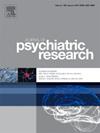Efficacy of continuous theta burst stimulation (cTBS) in the treatment of auditory verbal hallucinations in Schizophrenia: A randomized controlled trial
IF 3.2
2区 医学
Q1 PSYCHIATRY
引用次数: 0
Abstract
Background
Previous studies have shown that schizophrenic patients with auditory verbal hallucinations (AVH) respond poorly to antipsychotic drugs. Continuous theta burst stimulation (cTBS), as a new type of repetitive transcranial magnetic stimulation (rTMS) treatment, has shown therapeutic effect on reducing AVH. This study aims to evaluate the efficacy of cTBS on alleviating AVH and other psychotic symptoms in schizophrenic patients with AVH.
Methods
A total of 56 patients with AVH were recruited, and 50 patients were screened and ultimately included in the study. They were randomly divided into an active (cTBS) group and a control (sham) group. The active group received cTBS treatment using the left temporoparietal junction as the stimulation target, while the control group received sham stimulation. Both groups underwent a 2-week treatment. The Positive and Negative Syndrome Scale (PANSS), Auditory Hallucination Rating Scale (AHRS), and the Repeatable Battery for the Assessment of Neuropsychological Status (RBANS) were used to assess clinical symptoms and cognitive function at baseline and after 2 weeks of treatment.
Results
A total of 45 participants (25 in the active group and 20 in the sham group) completed the 2-week treatment. No significant difference (P > 0.05) in AHRS scores, PANSS total and subscale scores, as well as scores of cognitive functions was found between the active and sham groups at the end of the treatment. Notably, no serious adverse events occurred during the treatment period, indicating the good safety of the cTBS treatment.
Conclusions
The results indicated that cTBS might not present a significant advantage over sham TBS in improving AVH symptoms of schizophrenia. However, future studies with longer treatment duration and larger sample size are required.
连续θ波爆发刺激(cTBS)治疗精神分裂症患者听觉言语幻觉的疗效:一项随机对照试验
以往的研究表明,精神分裂症患者伴有听觉言语幻觉(AVH)对抗精神病药物的反应较差。连续θ波爆发刺激(cTBS)作为一种新型的重复经颅磁刺激(rTMS)治疗方法,已显示出降低AVH的疗效。本研究旨在评价cTBS对精神分裂症伴AVH患者缓解AVH及其他精神病症状的疗效。方法共招募56例AVH患者,其中50例经筛选最终纳入研究。随机分为活跃组(cTBS)和对照组(sham)。活性组以左颞顶交界处为刺激靶点进行cTBS治疗,对照组进行假性刺激。两组均接受2周的治疗。采用阳性和阴性综合征量表(PANSS)、幻听评定量表(AHRS)和神经心理状态评估可重复电池量表(rban)在基线和治疗2周后评估临床症状和认知功能。结果45例患者完成了2周的治疗,其中活性组25例,假手术组20例。治疗结束时,活跃组与假手术组的AHRS评分、PANSS总分、亚量表评分、认知功能评分均无显著差异(P > 0.05)。值得注意的是,在治疗期间未发生严重不良事件,表明cTBS治疗的安全性良好。结论cTBS在改善精神分裂症AVH症状方面可能没有明显优势。然而,未来的研究需要更长的治疗时间和更大的样本量。
本文章由计算机程序翻译,如有差异,请以英文原文为准。
求助全文
约1分钟内获得全文
求助全文
来源期刊

Journal of psychiatric research
医学-精神病学
CiteScore
7.30
自引率
2.10%
发文量
622
审稿时长
130 days
期刊介绍:
Founded in 1961 to report on the latest work in psychiatry and cognate disciplines, the Journal of Psychiatric Research is dedicated to innovative and timely studies of four important areas of research:
(1) clinical studies of all disciplines relating to psychiatric illness, as well as normal human behaviour, including biochemical, physiological, genetic, environmental, social, psychological and epidemiological factors;
(2) basic studies pertaining to psychiatry in such fields as neuropsychopharmacology, neuroendocrinology, electrophysiology, genetics, experimental psychology and epidemiology;
(3) the growing application of clinical laboratory techniques in psychiatry, including imagery and spectroscopy of the brain, molecular biology and computer sciences;
 求助内容:
求助内容: 应助结果提醒方式:
应助结果提醒方式:


